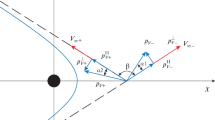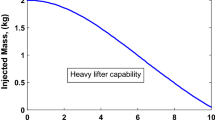Abstract
In the present work, a hybrid method for trajectory optimization of reentry spacecraft was proposed. The guiding legislation on the basis of heat reduction is presented in the procedure of obtaining the optimal trajectory. The heat rate should be decreased in the early phase of reentry flight by concentrating on the angle of attack profile. To meet terminal circumstances, the second step of suggested guidance included specifying the accurate profiles of the angle of attack and bank angle. A specific cost function should be minimized in each step. As a result, many optimization strategies have been utilized and compared. Due to its long flight duration and numerical sensitivity, the optimum trajectory issue of the space reentry vehicle (SRV) has been explored as one of the toughest problems in trajectory design. In both phases, the ideal trajectory for the optimality requirements has been discovered for various cost functions such as (i) overall heat rate, (ii) maximal heat rate, and (iii) terminal conditions. It may be inferred that the unique suggested strategy can minimize heat while maintaining the final conditions.


















Similar content being viewed by others
References
Rahimi A, Dev Kumar K, Alighanbari H (2012) Particle swarm optimization applied to spacecraft reentry trajectory. J Guid Control Dyn 36(1):307. https://doi.org/10.2514/1.56387
Pontryagin LS (1987) The mathematical theory of optimal processes. CRC Press
Betts JT, Kolmanovsky I (2002) Practical methods for optimal control using nonlinear programming. Appl Mech Rev 55:B68. https://doi.org/10.1115/1.1483351
Hargraves CR, Paris SW (1987) Direct trajectory optimization using nonlinear programming and collocation. J Guid Control Dyn 10(4):338. https://doi.org/10.2514/3.20223
Gurfil P, Kasdin NJ (2002) Niching genetic algorithms-based characterization of geocentric orbits in the 3D elliptic restricted three-body problem. Comput Methods Appl Mech Eng 191:5683–5706. https://doi.org/10.1016/S0045-7825(02)00481-4
Yokoyama N, Suzuki S (2005) Modified genetic algorithm for constrained trajectory optimization. J Guid Control Dyn 28(1):139. https://doi.org/10.2514/1.3042
Shafieenejad I, Novinzadeh AB, Molazadeh VR (2014) Comparing and analyzing min-time and min-effort criteria for free true anomaly of low-thrust orbital maneuvers with new optimal control algorithm. Aerosp Sci Technol 4(35):116–134. https://doi.org/10.1016/j.ast.2014.03.009
Shafieenejad I, Novinzadeh AB, Molazadeh VR (2015) Introducing a novel algorithm for minimum-time low-thrust orbital transfers with free initial condition. Proc Inst Mech Eng G J Aerosp Eng 229(2):333–351. https://doi.org/10.1177/0954410014533311
Duan H, Li S (2015) Artificial bee colony–based direct collocation for reentry trajectory optimization of hypersonic vehicle. IEEE Trans Aerosp Electron Syst 51(1):615–626. https://doi.org/10.1109/TAES.2014.120654
Graichen K, Petit N (2008) Constructive methods for initialization and handling mixed state-input constraints in optimal control. J Guid Control Dyn 31(5):1334–1343. https://doi.org/10.2514/1.33870
Berend N, Talbot C (2006) Overview of some optimal control methods adapted to expendable and reusable launch vehicle trajectories. Aerosp Sci Technol 10(3):222–232. https://doi.org/10.1016/j.ast.2005.11.004
Peng H, Yang C, Li Y, Zhang S, Chen B (2013) Surrogate-based parameter optimization and optimal control for optimal trajectory of Halo orbit rendezvous. Aerosp Sci Technol 26(1):176–184. https://doi.org/10.1016/j.ast.2012.04.001
Pan B, Lu P, Pan X, Ma Y (2016) Double-homotopy method for solving optimal control problems. J Guid Control Dyn doi 10(2514/1):G001553
Davis L (1991) Handbook of genetic algorithms. Van Nostrand Reinhold, New York
Gen M, Cheng R (2000) Genetic algorithms and engineering optimization, vol 7. Wiley, Newyork
Srinivas M, Patnaik LM (1994) Genetic algorithms: a survey. Computer 27(6):17–26. https://doi.org/10.1109/2.294849
Karaboga D, Basturk B (2007) A powerful and efficient algorithm for numerical function optimization: artificial bee colony (ABC) algorithm. J Glob Optim 39(3):459–471. https://doi.org/10.1007/s10898-007-9149-x
Karaboga D, Basturk B (2008) On the performance of artificial bee colony (ABC) algorithm. Appl Soft Comput 8(1):687. https://doi.org/10.1016/j.asoc.2007.05.007
Karaboga D, Akay B (2009) A comparative study of artificial bee colony algorithm. Appl Math Comput 214(1):108–132. https://doi.org/10.1016/j.jfranklin.2008.11.003
Akay B, Karaboga D (2012) Artificial bee colony algorithm for large-scale problems and engineering design optimization. J Intell Manuf 23(4):1001–1014. https://doi.org/10.1007/s10845-010-0393-4
Yusup N, Sarkheyli A, Zain AM, Hashim SZM, Ithnin N (2014) Estimation of optimal machining control parameters using artificial bee colony. J Intell Manuf 25(6):1463. https://doi.org/10.1007/s10845-013-0753-y
Ramadan HS, Fathy A, Becherif M (2017) Optimal gain scheduling of VSC-HVDC system sliding mode control via artificial bee colony and mine blast algorithms. IET Gener Trans Distrib 12(3):661. https://doi.org/10.1049/iet-gtd.2017.0935
Samani M, Tafreshi M, Shafieenejad I, Nikkhah AA (2015) Minimum-time open-loop and closed-loop optimal guidance with GA-PSO and neural-fuzzy for Samarai MAV flight. IEEE Aerosp Electron Syst Mag 30:28–37. https://doi.org/10.1109/MAES.2015.7119822
Chen W, Panahi M, Pourghasemi HR (2017) Performance evaluation of GIS-based new ensemble data mining techniques of adaptive neuro-fuzzy inference system (ANFIS) with genetic algorithm (GA), differential evolution (DE), and particle swarm optimization (PSO) fo landslide spatial modelling. CATENA 157:310–324. https://doi.org/10.1016/j.catena.2017.05.034
Abdulkhader HK, Jacob J, Mathew AT (2018) Fractional-order lead-lag compensator-based multi-band power system stabiliser design using a hybrid dynamic GA-PSO algorithm. IET Gener Transm Distrib 12:3248–3260. https://doi.org/10.1049/iet-gtd.2017.1087
Liu Y, Li X et al (2022) Evolutionary multi-objective trajectory optimization for a redundant robot in Cartesian space considering obstacle avoidance. Mech Sci 13:41–53. https://doi.org/10.5194/ms-13-41-2022
Zhang S (2022) An optimal design scheme of missile trajectory. journal of physics: conference series. In: 2022 International conference on automation and space science & technology. https://doi.org/10.1088/1742-6596/2220/1/012012
Ta E, Ar V, John L (2021) Costate mapping for indirect trajectory optimization. Astrodynamics 5:359–371. https://doi.org/10.1007/s42064-021-0114-0
Yang H, Li S, Bai X (2019) Fast homotopy method for asteroid landing trajectory optimization using approximate initial costates. J Guid Control Dyn 42(3):585–597. https://doi.org/10.2514/1.G003414
Funding
Not applicable.
Author information
Authors and Affiliations
Corresponding author
Ethics declarations
Conflict of interest
The authors declare that they have no conflict of interest.
Rights and permissions
Springer Nature or its licensor holds exclusive rights to this article under a publishing agreement with the author(s) or other rightsholder(s); author self-archiving of the accepted manuscript version of this article is solely governed by the terms of such publishing agreement and applicable law.
About this article
Cite this article
Ekrami Kivaj, A., Basohbat Novinzadeh, A. & Pazooki, F. Spacecraft reentry trajectory optimization by heuristic optimization methods and optimal control theory. Int. J. Dynam. Control 11, 1132–1141 (2023). https://doi.org/10.1007/s40435-022-01033-0
Received:
Revised:
Accepted:
Published:
Issue Date:
DOI: https://doi.org/10.1007/s40435-022-01033-0




